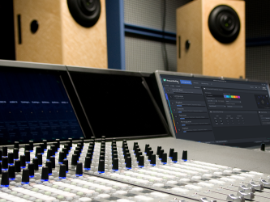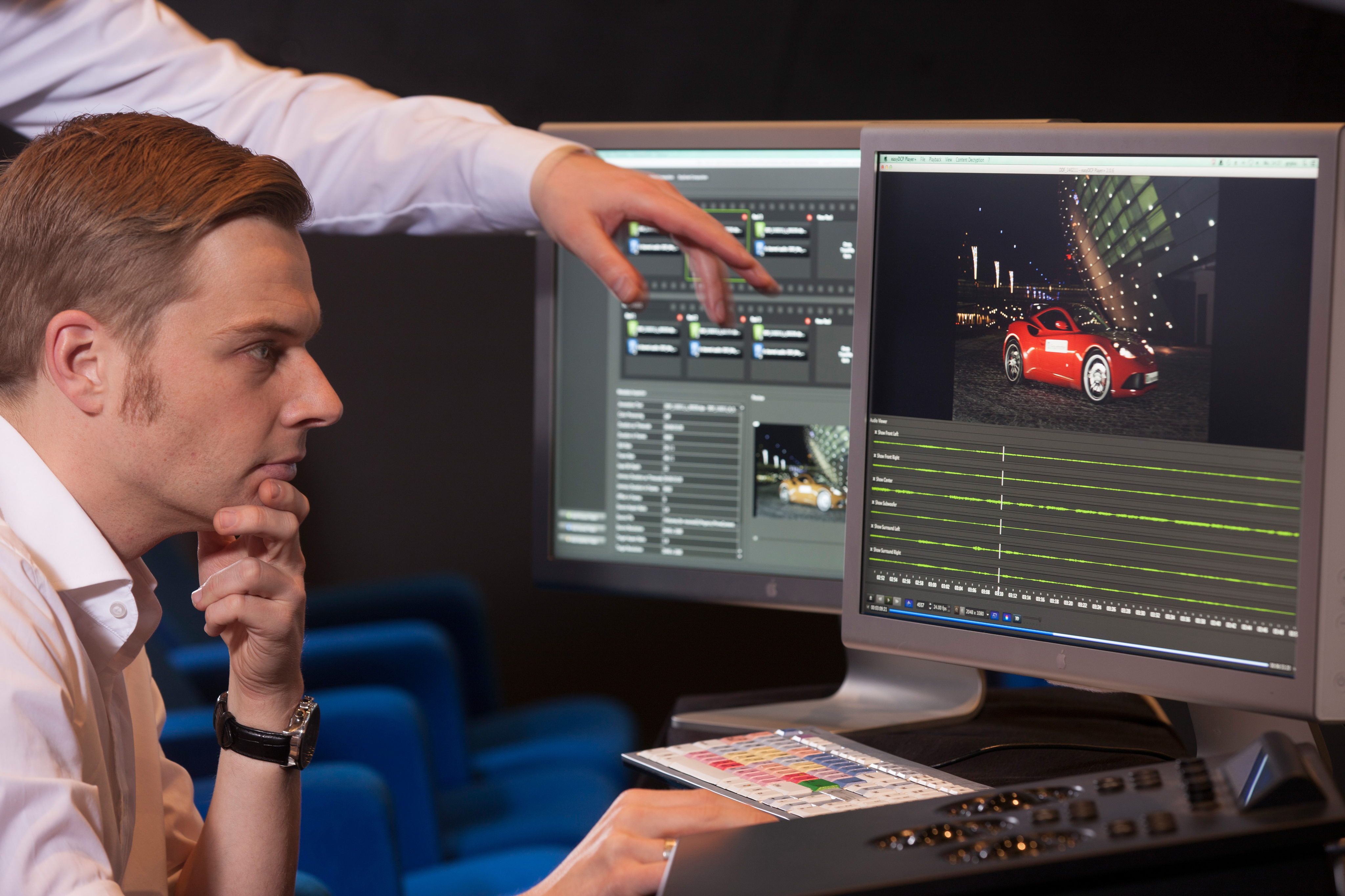Amsterdam / September 09, 2022 - September 12, 2022
IBC 2022
RAI Exhibition Center Amsterdam / Booth B.80 in hall 8
RAI Exhibition Center Amsterdam / Booth B.80 in hall 8

At the IBC trade show, Fraunhofer IIS is debuts the latest version (R7) of its professional ContentServer technology for DAB+ digital radio and DRM, available in products from Fraunhofer OEM partners. The ContentServer R7 has many new features, such as additional interfaces for IP-based audio streaming sources, automatic normalization and loudness monitoring (based on Fraunhofer Sonamic technology), and full CAP compliance for automatic processing of EWF (Emergency Warning Functionality) messages. The demo station will show, how the ContentServer generates multiplexes that are then played back via a Fraunhofer DAB+/DRM MultimediaPlayer radio application. In addition, the data applications Journaline and EWF, which are standardized in DAB+ and DRM, will be shown as part of the ContentServer R7 demo.
On the receiver side, Fraunhofer IIS offers various technologies for decoding and displaying digital radio services as part of its SDR (Software Defined Radio) solutions. The baseband software libraries from Fraunhofer support several transmission standards. This makes them an efficient means of expanding radio platforms to offer the full functionality of DAB + and DRM in combination with FM and AM decoding. The hybrid radio solution from Fraunhofer IIS will be presented at IBC 2022: it shows all components of a modern SDR-based radio system for receiving analog and digital radio services combined with the possibilities of Internet streaming. The software development is following the demands of the automotive industry for high quality and reliable systems. New methods for hybrid radio systems ensure seamless listening by automatically switching between the best reception among analog, digital and internet radio. Especially for listening pleasure in the car with several audio zones and additional digital information services, several independent receiving units can be active on a radio platform at the same time.

The MPEG-H Audio System enables immersive and interactive sound that can be personalized. Listen to a 3D audio experience that perfectly matches your preferences. With MPEG-H Audio, you can choose from presets or create your own settings. For example, it is now possible to switch between languages, and adjust the volume of a sports commentator. It also provides enhanced accessibility features such as dialogue enhancement and audio description. These features enhance the pristine 3D sound and flexibility that consumers expect from quality services today.
With MPEG-H Audio, next-generation audio is already a reality, as the system has been on the air 24/7 in South Korea since the UHDTV system was launched there in May 2017. In addition to that, is has recently been selected as the only mandatory audio codec of Brazil’s new TV ecosystem, TV 3.0.
The system is also used for music streaming, as Sony's immersive 360 Reality Audio format is based on MPEG-H Audio. The immersive music tracks, available from providers such as Amazon Music, Deezer, and TIDAL, can be played on mobile devices (with headphones), soundbars, smart speakers, and in the car.
Understanding TV dialogue better – with MPEG-H Dialog+ technology
Most TV stations are quite used to their audience complaining about hard-to-understand dialogue – be it in films, documentaries, sports coverage, and even the news. The matter is not an easy one to solve. Firstly, because the loudness difference between background sound and dialogue is a unique decision made by creators for every piece of content, and secondly, because the “perfect” dialogue loudness is a very personal issue.
The evolution of AI-based technologies and object-based audio (OBA), however, has enabled the creation of technologies such as MPEG-H Dialog+ by Fraunhofer IIS. The technology uses Deep Neural Networks (DNN) to automatically identify the dialogue of existing content, separate it from the background sounds, and remix it with a lowered background level. Using OBA, users can even adapt the dialogue level on their device to meet their personal requirements.
MPEG-H Dialog+ contains a deep neural network that performs dialogue separation using training data derived mostly from real-world broadcast content. Dialog+ combines dialogue separation with a unique automatic remixing algorithm, where a global and a time-varying background attenuation can be combined.
MPEG-H Dialog+ is part of the MPEG-H Audio production software, providing all features of an OBA system like advanced user interactivity and personalization. This makes the use of MPEG-H Dialog+ a future-proof decision for broadcasters and content producers as MPEG-H Audio is one of the most advanced Next Generation Audio systems on the market. It has already been chosen as a TV audio standard by countries such as Brazil and South Korea.

MPEG-H Authoring Suite 5.0: Your complete MPEG-H tool chain
The MPEG-H Audio system delivers immersive sound on every kind of playback device – from home theaters to 3D soundbars to mobile devices. For the easy creation of such audio experiences, Fraunhofer IIS has developed a complete set of tools for the creation of audio and video content with object-based 3D Audio. The MPEG-H Authoring Suite (MAS) 5.0 now includes all tools required for authoring, encoding, and playback of MPEG-H Masters as well as encoded MPEG-H. With the comprehensive range of instruments, producers and broadcasters deliver immersive soundscapes that users can adapt to their personal needs and preferences. This can happen within a predefined framework by including fully adjustable dialogue levels, customizable audio description, multiple languages, and even interactive object positioning.
The MAS 5.0 makes the production of MPEG-H easier, faster, and available for everybody. It can be used in all areas of the field from radio and TV broadcast to immersive music streaming and supports authoring and export in production environments running at 48kHz or 96kHz sample rates.

Say goodbye to interrupted or buffering audio and video streams: the latest addition to the AAC codec family offers maximum coding efficiency, with a stereo bitrate range from 12 kbit/s to 500 kbit/s and higher. Combined with seamless bitrate adjustment using DASH and HLS, as well as mandatory MPEG-D DRC volume and dynamic range adjustment, xHE-AAC is the ideal solution for adaptive audio and video streaming services - whether movies, music, audiobooks or podcasts - as well as digital radio. xHE-AAC decoding is natively supported in Android OS 9 and higher, Fire OS 7 and iOS 13. Fraunhofer also offers a web-based testing service that developers and manufacturers can use to check their implementations of the xHE-AAC® audio codec for compliance with MPEG standards. The free service can be used to test both encoders and decoders. It is exclusively available at https://test.xhe-aac.com/ and can be used after registration at Fraunhofer IIS.
At the Fraunhofer IBC booth, visitors can experience the benefits of xHE-AAC in video and internet radio streaming applications.

The new LC3/LC3plus audio codec was developed to address the drawbacks of today's wireless communication platforms. The low complexity of the codec meets the requirements of wireless communication platforms such as Bluetooth, DECT, and VoIP terminals. By reducing the required bit rate by about 50 per cent compared to older codecs, LC3 and LC3plus enable energy-saving services that allow for longer battery life or the development of smaller products. Thanks to the flexible codec design, applications are not limited to voice services, but can also be extended to high-quality music streaming. Even High-Resolution Audio streaming over the A2DP profile is supported by LC3's sibling LC3plus. At the same time, the codec operates with low coding delay, low computational complexity and small memory requirements. Learn more about LC3/LC3plus at our booth.

JPEG XS stands for extra speed and extra small. The new ISO mezzanine codec standard co-developed by the Fraunhofer Institute for Integrated Circuits enables interoperability and allows an easy and cost-effective integration into IP-based infrastructure.
As an ultra low-latency lightweight image coding system, JPEG XS offers visually lossless quality with compression ratios up to 10:1. It also supports resolution up to 8K and features a frame rate from 24 to 120fps.
Whether Virtual Reality, gaming, in-house or broadcast and digital cinema workflows, the JPEG XS mezzanine codec can be applied where today uncompressed video is used.
At IBC 2022 we will offer and demonstrate our JPEG XS software encoder and decoder and an implementation.
We were able to improve the PSNR (Power Signal Noise Ratio) up to 10 dB for mixed signal and screen content.
Fraunhofer IIS offers JPEG XS SDKs for x86 CPUs, ARM CPUs and NVidia GPUs.
Licensing available for software and SDKs.
More information

The post-production software easyDCP has secured its place on the market for the creation, playback and quality control of Digital Cinema Packages DCPs for more than ten years. Meanwhile, more than 1,800 post-production houses and customers worldwide are using the easyDCP tools that are not only available as a standalone version, but also as plug-ins for well-known post-production software such as Blackmagic Design DaVinci Resolve. New features are validation against RDD52, MCA labelling, CPL marker as well as a new subscription licensing model. The new software suite is a hardware-independent license that enables workflows in the cloud or cloud environments and manages operations on multiple computers.